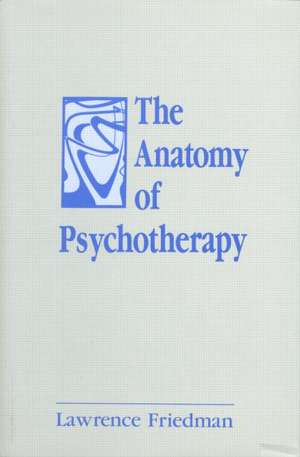The Anatomy of Psychotherapy
Autor Lawrence Friedmanen Limba Engleză Hardback – iun 1988
The Anatomy of Psychotherapy describes how the therapist makes use of theories and styles in order to achieve equilibrium under stress. This stress, according to Friedman, is related to the "absolute ambiguity" that is essential to psychotherapy. To cope with this ambiguity, the therapist alternates among three different roles, those of reader, historian, and pragmatic operator. Friedman examines these "disambiguating postures" in detail, paying special attention to their bearing on the therapist's narrative prejudice, the relativity of his knowledge, and the relationship of his work to natural science and hermeneutics.
Brilliantly constructed and masterfully written, The Anatomy of Psychotherapy traverses the same basic themes in each of its six sections. Readers who are interested in theory can hone in on relevant topics or the work of particular theorists. Readers seeking insight into the demands of daily clinical work, on the other hand, can bypass the systematic studies and immerse themselves in Friedman's engrossing reflections on the experience of psychotherapy. Best served will be those who ponder Friedman's writings and therapy as complementary meditations issuing from a single, unifying vision, one in which psychotherapy, in both its promise and frustrations, becomes a subtle interplay among theories about psychotherapy, the personal styles of psychotherapists, and the practical exigencies of aiding those in distress.
| Toate formatele și edițiile | Preț | Express |
|---|---|---|
| Paperback (1) | 417.04 lei 6-8 săpt. | |
| Taylor & Francis – 23 iun 2015 | 417.04 lei 6-8 săpt. | |
| Hardback (1) | 929.34 lei 6-8 săpt. | |
| Taylor & Francis – iun 1988 | 929.34 lei 6-8 săpt. |
Preț: 929.34 lei
Preț vechi: 978.25 lei
-5% Nou
Puncte Express: 1394
Preț estimativ în valută:
177.85€ • 183.48$ • 150.52£
177.85€ • 183.48$ • 150.52£
Carte tipărită la comandă
Livrare economică 05-19 martie
Preluare comenzi: 021 569.72.76
Specificații
ISBN-13: 9780881630534
ISBN-10: 0881630535
Pagini: 616
Dimensiuni: 152 x 229 x 45 mm
Greutate: 1.02 kg
Ediția:1
Editura: Taylor & Francis
Colecția Routledge
Locul publicării:Oxford, United Kingdom
ISBN-10: 0881630535
Pagini: 616
Dimensiuni: 152 x 229 x 45 mm
Greutate: 1.02 kg
Ediția:1
Editura: Taylor & Francis
Colecția Routledge
Locul publicării:Oxford, United Kingdom
Public țintă
Professional and Professional Practice & DevelopmentCuprins
I. Theory and Practice: The Trouble with Psychotherapy 1. Whatever Happened to the Therapist's Discomfort? 2. Discomfort Reflected in Theory: The Therapeutic Alliance 3. Looking to Theory for Help 4. Descriptive Help from Theory: Trends in the Psychoanalytic Theory of Treatment 5. Other Uses of Theory 6. Overview II. Practice Observed 7. Leaving Theory Temporarily 8. What Moves the Therapist? 9. Therapy Tasks that Theoy Must Explain 10. Therapy Tasks: How the Therapist Makes Sense of the Patient 11. Therapy Tasks: How the Patient Makes Sense of the Therapist III. Theory of the Mind: The Tool of Psychotherapy 12. Why Bother with Theory of the Mind? 13. The Historical Context 14. Freud's Foothold 15. Constructions of Freud's Paradigmatic Theory 16. Conclusion: The Nature and Function of a Theory of the Mind IV. Debate About Theory of the Mind: Revisions 17. Introduction 18. Peterfreund's Information-Processing Theory 19. Phenomenological Theory: Mind as a World of Representations 20. Schafer's Action Language 21. Levenson's Perspectivism 22. Gendlin's Vitalism 23. George Klein's Equilibrium Theory 24. Piaget's General Project 25. Piaget and Psychotherapy 26. Kohut's Mixed Theory 27. The Common Thread: Holism 28. Summary: The Need to Balance Perception and Influence V. What is a Psychotherapist 29. Ambiguity as a Discipline 30. Disambiguating Postures: General Considerations 31. Disambiguating Postures: The Reading Imperative 32. Disambiguating Postures: The Therapist's Historicism 33. Disambiguating Postures: The Therapist as Operator 34. How It Fits Together: Performable Model and Metaphor VI. Implications 35. Conclusion: No Resting Place 36. Training 37. The Future
Notă biografică
Lawrence Friedman, M.D., is Clinical Professor of Psychiatry and a member of the History of Psychiatry section of the Department of Psychiatry, Cornell University Medical College. Dr. Friedman is the 1985 recipient of the American Psychoanalytic Association's Distinguished Contributor Award.
Recenzii
"For the first time, the psychoanalytic theory of treatment has received the detailed, penetrating, and resourceful scrutiny hitherto reserved for psychopathology. Friedman's work appears at a critical time, when psychological efforts are under heavy attack and in need of this systematic and profound presentation."
- Leston Havens, M.D., Professor of Psychiatry, Harvard Medical School
“It is a treasure trove of thoughtful ideas in which exposition, exploration, and criticism are harmoniously interwoven.”
- Steven T. Levy, M.D., Psychoanalytic Quarterly
“Psychoanalysts, psychotherapists, supervisors, teachers, and students of the field will find this a rich and rewarding work. It will influence the way I supervise, teach, and talk to patients for the rest of my career.”
- Robert Michels, M.D.. Department of Psychiatry, Cornell University Medical College
- Leston Havens, M.D., Professor of Psychiatry, Harvard Medical School
“It is a treasure trove of thoughtful ideas in which exposition, exploration, and criticism are harmoniously interwoven.”
- Steven T. Levy, M.D., Psychoanalytic Quarterly
“Psychoanalysts, psychotherapists, supervisors, teachers, and students of the field will find this a rich and rewarding work. It will influence the way I supervise, teach, and talk to patients for the rest of my career.”
- Robert Michels, M.D.. Department of Psychiatry, Cornell University Medical College
Descriere
In this brilliant examination of how the therapist makes use of theories and styles in order to achieve equilibrium under stress, Lawrence Friedman probes the subtle interplay of theory and practice and offers penetrating assessments of recent theories o






















